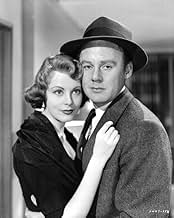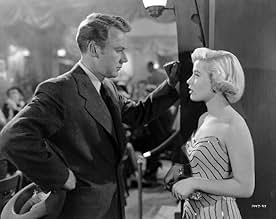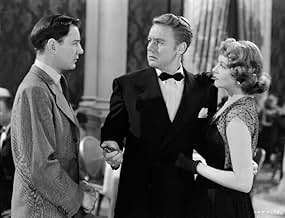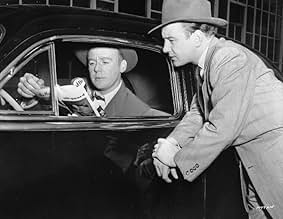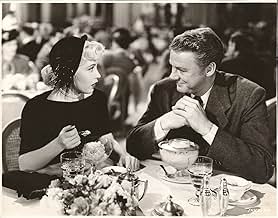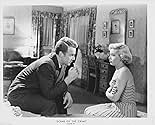ÉVALUATION IMDb
6,6/10
1,6 k
MA NOTE
Ajouter une intrigue dans votre langueWhile his wife is urging him to quit the force, a Los Angeles homicide detective hunts for the killer responsible for the murder of his ex-partner, who might have been on the take with local... Tout lireWhile his wife is urging him to quit the force, a Los Angeles homicide detective hunts for the killer responsible for the murder of his ex-partner, who might have been on the take with local bookies.While his wife is urging him to quit the force, a Los Angeles homicide detective hunts for the killer responsible for the murder of his ex-partner, who might have been on the take with local bookies.
- Director
- Writers
- Stars
- Prix
- 1 nomination au total
Gloria DeHaven
- Lili
- (as Gloria De Haven)
Bette Arlen
- Girl with Sleeper
- (uncredited)
Avis en vedette
I guess the lesson here is that you can take the crime drama out of MGM, but you can't take MGM out of the crime drama. With noirish location shots, the new Dore Schary regime changed the usual MGM look somewhat, yet the movie still boasts a string of stars and star power for which the studio was known. The trouble is that working Van Johnson, Arlene Dahl, Tom Drake, Gloria DeHaven, Donald Woods, and a string of "name" supporting players into the screenplay with sufficient screen time for each overstretches the results. Despite some effective moments (the hotel room fistfight, the fright screams from the burning car), the movie suffers from too much flab for overall effect. For example, the two rather lengthy scenes with Norrie Lorfield (Tom Helmore), the rival for Conovan's (Johnson) wife, are simply a needless distraction from the main plot, and work to dilute the overall effect. In fact, the entire marital subplot should have been dropped or at least minimized, but it seems that the studio was not satisfied with the kind of fast, efficient little crime drama that RKO, for one, routinely turned out.
I'm tempted to say that just as movie spectaculars and historical epics depend on big budgets for optimal effect, crime dramas and noirs depend on the tight disciplining constraints of small ones. That way, production values don't interfere with the story line. Here it appears that MGM's celebrated production values over-produced the number of feature players, which, in turn, multiplied the various subplots, or vice-versa. In either case, it's too bad the script didn't eliminate a few of these in favor of giving Norman Lloyd's truly memorable character, Sleeper, more screen time. He's the kind of unique character that could have transformed this otherwise forgettable exercise into a memorable one.
I'm tempted to say that just as movie spectaculars and historical epics depend on big budgets for optimal effect, crime dramas and noirs depend on the tight disciplining constraints of small ones. That way, production values don't interfere with the story line. Here it appears that MGM's celebrated production values over-produced the number of feature players, which, in turn, multiplied the various subplots, or vice-versa. In either case, it's too bad the script didn't eliminate a few of these in favor of giving Norman Lloyd's truly memorable character, Sleeper, more screen time. He's the kind of unique character that could have transformed this otherwise forgettable exercise into a memorable one.
An LA police detective (Van Johnson) investigates the murder of another detective and gets involved with night club singer and stripper played by Gloria De Haven. The story has a neat double cross. A criminal organization from "down south" sends a couple of "lobos" to LA in order to take over a bookmaking syndicate. Corruption is at the center of the story as the dead detective was carrying a wad of cash. Johnson's out to prove that he (dead detective) wasn't on the take. His street contact Sleepy (Norman Lloyd) provides some of the films more vivid moments, and Jerome Cowan (Sam Spade's partner in Maltese Falcon) has a great part as "fixer" Arthur Webson. Johnson does very well in the part, combining breeziness that he honed in earlier films with sufficient grit to be believable as a tough detective. His wife played by Arlene Dahl looks great and they share some pretty good chemistry in their scenes. The film does a good job of capturing the story's different elements and cohesively combining them. The action doesn't always come, but when it does it is surprisingly sudden and brutal for the times.
Two veteran Los Angeles police detectives and a well-meaning rookie set out to find the killer of an off-duty fellow officer who may have been on the take. This is an L.A. filled with dangerous broads, bookie joints, ex-bootleggers in on a new racket, and cops in natty suits and broad-billed hats. The pulpy, slangy dialogue is fun at times, as are the performances from Van Johnson and Gloria DeHaven (playing a chanteuse "with a figure like champagne and a heart like the cork"). Other, later crime-dramas would quickly up the ante on such a scenario, but this one is a fine example of the compact policer. M-G-M was downsizing their budgets at the time and trying their hand at different types of films--which provided the perfect opportunity for matinée idols like Johnson to stretch their acting muscles. The results here are not exactly noir, but more from an overtly-ordinary, overtly-jaded mold, with everyday people going about their business and getting the job done. If it isn't exciting, at least it's highly competent. **1/2 from ****
This is a very good film noir, well directed by Roy Rowland and with strong casting. It is based on a story called 'Smashing the Bookie Gang Marauders', which provided a run of the mill plot. But the strongest aspect of this film is its intelligent and witty screenplay by Charles Schnee. The film has many quick ripostes and lots of snappy dialogue. But unlike many such films, where gag writers have inserted the gags, there are no gags in this film, and instead Schnee has written his own text with plenty of quick zippy wit. One particularly good line is when Van Johnson says to floozy Gloria DeHaven: 'You know, when girls have your kind of looks, it's hard to see them.' That was because he had misread her character. Van Johnson is at his best as the stalwart cop in this detective tale. His beautiful wife is played by Arlene Dahl, to great effect. Gloria DeHaven is the gangster's moll, and she is some looker. She almost had me fooled too. All that soft soap concealing the hard steel underneath is enough to make any guy doubt the reliability of dames sometimes. The story concerns some wild thugs who are wiping out the bookies and killing people without compunction, in an attempt to 'take over'. The main murderer is a man with a twisted hand and a blotchy face. But no one can find him. It is interesting from the dialogue in the film that at that time tough guys did not say: 'Where is he holed up?' but merely: 'Where is he holed?' And another linguistic surprise is that Van Johnson talks of people spending time together as 'hanging', as in the phrase 'hanging out' used by young people today. I had no idea that people in 1949 were already talking about 'hanging' with each other. It all goes to show how important movies can be for one's historical education in the evolution of slang. In fact, there is no substitute for them. And that is yet another reason for watching old movies nonstop.
This is a very entertaining look at big city cops and robbers with shades of film noir showing though. The standout performance in a potentially femme fatale role is Gloria DeHaven. I suspect the writers, John Bartlow Martin and Charles Schnee, along with director Roy Rowland, had experiences with untrustworthy women, for Lili (Gloria DeHaven) could turn any man's heart to putty, then fool him over and over. Van Johnson too turns in a subdued performance which is called for in the character (Mike Conovan) he plays. Conovan's very liberal wife, especially for 1949, is played by Arlene Dahl, who is fed up with the demands of her husband's job but who also trusts her husband to be with a vixen and still stay true to her. This is an effective counterbalance to the untrustworthiness of Lili. Great supporting roles abound filled with standout performances from John McIntire's "too old to cut the mustard" part all the way to the Sleeper, Norman Lloyd. Yuk, Yuk, it's great. There is a lot of realistic blood and guts thrown in complete with car chases that foretell things to come in action movies. Heat up some popcorn, get a cold one, then sit back and enjoy the ride.
Le saviez-vous
- AnecdotesThis film has many actors cast against previous types. Van Johnson had appeared in light comedies and musicals, making him a teen idol at the time. His versatility, proven in this film, would lead to his role in Bastogne (1949). Gloria DeHaven has previously been cast as sweet, innocent girls, but here she is a stripper and gun moll. Gorgeous Arlene Dahl, formerly a high-paid covergirl before marrying Mike, spurns the glamorous life and tries hard to accept the role the stay-at-home wife of a cop (whom she is desperately in love with, and daily fears losing).
- GaffesWhen Detective Piper introduces the young man that sold the .38 S&W revolver to the cop killer to detective Conovan the man says he sold the gun to a man in a bar. Conovan then assails the man over his getting a lousy eighty bucks for the gun that killed his former partner - lousy in what became of the gun, not the price, easily twice what the gun was worth. But at no time did the man or Piper mention getting that amount for the gun. It appears Piper had already reported in by phone, perhaps via CC, as Conovan did not register the least surprise at him appearing at the headquarters with the former gun owner in tow. And Conovan acted as though he already was familiar with the gist of the pickup, and was on edge and ready to talk hostilely to the young man, even threaten unlawful activities toward him.
- Citations
Sleeper: Naturally, I know you know I know somethin'.
Mike Conovan: I know you know I know you know somethin'.
- ConnexionsFeatured in Some of the Best: Twenty-Five Years of Motion Picture Leadership (1949)
- Bandes originalesI'M A GOODY-GOODY GIRL
(uncredited)
Music by André Previn
Lyrics by William Katz
Sung (with partial striptease) by Jean Carter
Meilleurs choix
Connectez-vous pour évaluer et surveiller les recommandations personnalisées
- How long is Scene of the Crime?Propulsé par Alexa
Détails
- Date de sortie
- Pays d’origine
- Langue
- Aussi connu sous le nom de
- La ciudad del crimen
- Lieux de tournage
- 259 E. 5th Street, Los Angeles, Californie, États-Unis(site of Hippo's Coffee Pot)
- société de production
- Consultez plus de crédits d'entreprise sur IMDbPro
Box-office
- Budget
- 761 000 $ US (estimation)
- Durée1 heure 34 minutes
- Couleur
- Rapport de forme
- 1.37 : 1
Contribuer à cette page
Suggérer une modification ou ajouter du contenu manquant

Lacune principale
By what name was Scene of the Crime (1949) officially released in India in English?
Répondre


